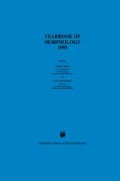Abstract
According to Booij (1995) it is necessary to distinguish between two types of inflection in order to account for the fact that some inflectional forms may serve as the input to derivational rules. The first type, which he refers to as ‘inherent inflection’ is not required by the syntactic context (although it does have syntactic relevance) and sometimes involves semantic change. It includes categories such as noun number, the comparative and superlative degree of adjectives, participles, tense and aspect of verbs etc. The second type, ‘contextual inflection’, reflects aspects of syntactic structure and includes categories such as agreement (e.g. between subject and verb, between noun and adjective) and case marking. Booij states that only inherent inflection may feed derivation and gives a variety of examples from modern standard Dutch to illustrate his point.
Notes
Many thanks to Dr Jon West, University of Newcastle upon Tyne, for his helpful comments.
Access this chapter
Tax calculation will be finalised at checkout
Purchases are for personal use only
Preview
Unable to display preview. Download preview PDF.
References
Anderson, S.R. 1992. A-morphous Morphology Cambridge: Cambridge University Press. Booij, G.E. 1994. “Against Split Morphology”. In G.E. Booij and J. van Marle (eds.), Yearbook of Morphology 1994 Dordrecht: Kluwer, 27–50.
Booij, G.E. 1995. “Inherent versus Contextual Inflection and the Split Morphology Hypothesis”. In G.E. Booij and J. van Marle (eds.), Yearbook of Morphology 1995. Dordrecht: Kluwer, 1–16.
Chapman, C. 1994. “A Diachronic Argument against the Split Morphology Hypothesis: Analogical Umlaut in German Dialects”. Transactions of the Philological Society 92, 25–39.
Chapman, C. 1995. “Perceptual Salience and Analogical Change: Evidence from Vowel Lengthening in Modern Swiss German Dialects”. Journal of Linguistics 31, 1–13.
Chapman, C. Forthcoming. “Diminutive Plural Infixation and the `West Franconian’ Problem”. In J. Fisiak (ed.), Linguistic Reconstruction and Typology Berlin: Mouton de Gruyter.
Di Sciullo, A.M. and Williams, E. 1987. On Defining the Word. Cambridge, Mass.: MIT Press.
Donaldson, B.C. 1981. A Dutch Reference Grammar. ‘s-Gravenhage: Nijhoff. Donaldson, B.C. 1993. A Grammar of Afrikaans. Berlin, New York: Mouton de Gruyter. Drosdowski, G. 1989. Duden Universalwörterbuch. Mannheim: Duden.
Fleischer, W. 1971. Wortbildung der deutschen Gegenwartssprache. Leipzig: VEB Bibliographisches Institut.
Katamba, F. 1993. Morphology. London: Macmillan.
Lloyd, P.M. 1968. Verb-Complement Compounds in Spanish. Tübingen: Niemeyer.
Marle, J. van 1985. On the Paradigmatic Dimension of Morphological Creativity. Dordrecht: Foris.
Matthews, P.H. 1974. Morphology. Cambridge: Cambridge University Press.
Mayerthaler, W. 1981. Morphologische Natürlichkeit. Wiesbaden: Athenaion. Menéndez-Pidal, R. 1966. Manual de gramdtica histórica espanola. Madrid: Espasa-Calpe, S.A.
Morris Jones, J. 1970. A Welsh Grammar. Historical and Comparative. Oxford: Oxford University Press.
Perlmutter, D. M. 1988. “The Split Morphology Hypothesis, Evidence from Yiddish”. In M. Hammond and M. Noonan (eds.), Theoretical Morphology. San Diego: Academic Press, 79–100.
Quirk, R. et al. 1985. A Comprehensive Grammar of the English Language. London: Longman. Scalise, S. 1988. “Inflection and Derivation”. Linguistics 26 /4, 561–83.
Selkirk, E.O. 1982. The Syntax of Words. Cambridge, Mass.: MIT Press.
Stephens, J. 1993. “Breton”. In M. J. Ball (ed.), The Celtic Languages. London: Routledge. Stump, G. T. 1991. “A Paradigm-Based Theory of Morphosemantic Mismatches”. Language 67, 675–720.
Author information
Authors and Affiliations
Editor information
Editors and Affiliations
Rights and permissions
Copyright information
© 1996 Springer Science+Business Media Dordrecht
About this chapter
Cite this chapter
Chapman, C. (1996). Perceptual salience and affix order: noun plurals as input to word formation. In: Booij, G., van Marle, J. (eds) Yearbook of Morphology 1995. Yearbook of Morphology. Springer, Dordrecht. https://doi.org/10.1007/978-94-017-3716-6_10
Download citation
DOI: https://doi.org/10.1007/978-94-017-3716-6_10
Publisher Name: Springer, Dordrecht
Print ISBN: 978-90-481-4687-1
Online ISBN: 978-94-017-3716-6
eBook Packages: Springer Book Archive

